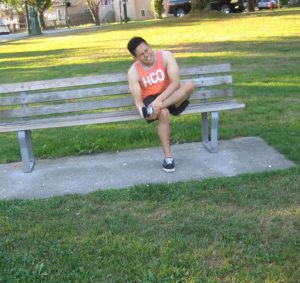Plantar fasciitis causes pain in the heel and the bottom of the foot. It is a band of thick tissue connecting the heel bone to the toes. It can be stretched, torn or injured and even inflamed. When the area becomes inflamed, it is called plantar faciitis.
Symptoms of plantar fasciitis
- Pain in the heel that spreads into the foot
- Tenderness under the sole of the foot and inside the heel when pressed
- Pain can be mild to severe which depend on the area affected
- Pain is severe usually in the morning upon waking up because the foot is in a relaxed position and becomes shortened. Walking around can lessen the pain as the tissues are warmed up and stretched.
Tenderness under the sole of the foot and inside the heel when pressed. - Pain in the area when sitting for long periods of time
Causes
- Overuse injury due to overstretching of the plantar fascia
- Overpronation
- High-arched foot
- Wearing ill-fitting shoes
- Tight calf muscles
- Being overweight
- Previous injuries
Treatment
- Take plenty of rest especially the affected foot to lessen the pain due to plantar fasciitis.
- Use crutches for a few days to lessen the pressure placed on the foot and for fast healing of the condition.
- Perform gentle exercises for the foot such as swimming or weightlifting.
- Wear a foot support such as arch support that spreads evenly the pressure of the foot which can lessen excessive stress on the plantar fascia. Another alternative is wearing a heel cup.
- Apply an ice pack or cold compress on the affected area to lessen the inflammation and pain. Apply the pack under the foot for at least 20 minutes at 3-4 times every day. Avoid applying the pack directly on the skin to prevent further damage and worsen the condition. Another alternative is a foot tub filled with ice and water and soak the affected foot for at least 10-15 minutes.
- Wrap the foot to lessen the symptoms especially the pain felt under the heel. It lessens some of strain placed on the plantar fascia. Wrap the bandage around the ankle and gently pull the toes up toward the head where a light stretch can be felt. Place one end of the elastic bandage on top of the foot and keep the foot flexed and bring the bandage around the foot and ankle. Avoid wrapping it too tight to prevent any disruption in the blood circulation in the area and worsen the condition. The purpose of the bandage is to keep the foot flexed and stretching of the plantar fascia.
- Take the prescribed over-the-counter pain medications to lessen the pain and inflammation of the foot.
Disclaimer / More Information
The material posted on this page on plantar fasciitis is for learning purposes only. Learn to recognize and manage foot pain due to plantar fasciitis by taking a first aid and CPR class with one of our training providers.
FACT CHECK
https://www.mayoclinic.org/diseases-conditions/plantar-fasciitis/symptoms-causes/syc-20354846
https://orthoinfo.aaos.org/en/diseases–conditions/plantar-fasciitis-and-bone-spurs
https://www.healthline.com/health/plantar-fasciitis


